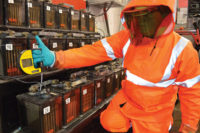Unfortunately the assessment is sometimes triggered by an unplanned incident such as an electrical shock injury, an arc flash burn, an unexpected shutdown, unexplained equipment damage, or an inoperative emergency power system. The results of an electrical hazard risk assessment constitute one of the most important factors in the selection of PPE; developing or updating training programs; and developing or revising an electrical safety program, along with safe work procedures.
Direction and resources for conducting an electrical hazard risk assessment are available to industry. Primary drivers for hazard assessments are OSHA, the National Fire Protection Association (NFPA), and the Institute of Electrical and Electronics Engineers (IEEE).
Following is a list of specific regulations and standards you should consult:
• OSHA 1910 Subpart I, Personal Protective Equipment, Section 1910.132, General Requirements, (d) Hazard assessment and equipment selection
• OSHA 1910.331-.335, Electrical Safety-Related Work Practices
• OSHA 1910.269, Electric Power Generation, Transmission, and Distribution (where applicable)
• IEEE Std 3007.1 IEEE Recommended Practice for the Operation and Management of Industrial and Commercial Power Systems
• IEEE Std 3007.2 IEEE Recommended Practice for the Maintenance of Industrial and Commercial Power Systems
• IEEE Std 3007.3 IEEE Recommended Practice for Electrical Safety in Industrial and Commercial Power Systems
• ANSI/IEEE C2, National Electrical Safety Code (where applicable)
• NFPA 70, National Electrical Code (NEC)
• NFPA 70B, Recommended Practice for Electrical Equipment Maintenance
• NFPA 70E, Standard for Electrical Safety in the Workplace
OSHA 1910.132(d)(1) requires the employer to “assess the workplace to determine if hazards are present, or are likely to be present, which necessitate the use of personal protective equipment (PPE).” NFPA 70E-2015, Section 130.3 Working While Exposed to Electrical Hazards provides the requirement to perform electrical hazard risk assessments before any person is exposed to electrical hazards. Section 130.4 provides more specific direction for the shock hazard risk assessment and 130.5 for the arc flash hazard risk assessment process for establishing the protection boundaries for these hazards, as well as identifying the required PPE. This information is required as part of the electrical safety program. The shock hazard risk assessment is used to determine the voltage exposure, shock protection boundaries, and the required PPE necessary to protect employees and minimize the possibility of electrical shock. The arc flash hazard risk assessment is also used to help protect employees by establishing the arc flash protection boundary and required PPE to protect employees.
1910.132(d)(1) also requires that “if such hazards are present, or likely to be present, the employer shall:
(i) Select, and have each affected employee use, the types of PPE that will protect the affected employee from the hazards identified in the hazard assessment;
(ii) Communicate selection decisions to each affected employee; and,
(iii) Select PPE that properly fits each affected employee.”
OSHA 1910.132(d)(2) further requires employers to certify that they performed a hazard assessment. The signed certification must include the date of the hazard assessment and the identification of the workplace evaluated (area or location). OSHA compliance officers may require employers to disclose certification records during an Agency inspection.
Electrical hazard risk assessments also identify the requirements for an Energized Electrical Work Permit, as required by NFPA 70E-2015, Section 130.2(B). Where employees are working within the Restricted Approach Boundary of exposed energized electrical conductors or circuit parts that are not placed in an electrically safe work condition or where the employee interacts with the equipment where conductors or circuit parts are not exposed but an increased risk of injury from exposure to an arc flash hazard exists, the work to be performed is considered energized electrical work; therefore, an Energized Electrical Work Permit is required. The Energized Electrical Work Permit must be written, signed and authorized by management, and it must be used in order to protect employees who are or may be exposed to any electrical hazards. Essentially the electrical hazard risk assessment helps to ensure that the training and PPE selected is appropriate for the hazards present in the workplace.



